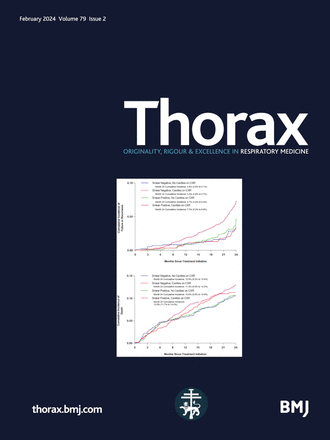日常变异性指数提高了振荡测量法在儿科哮喘中的应用
IF 7.7
1区 医学
Q1 RESPIRATORY SYSTEM
引用次数: 0
摘要
背景:振荡测量法可为儿童哮喘的客观远程监测提供可行、灵敏的工具。方法对学龄健康、控制良好和控制不良的哮喘患者进行为期3-4个月的观察性研究,并对其进行哮喘控制(每周哮喘控制问卷和每月哮喘控制测试)、药物使用和恶化情况的客观测量。日常变异性计算为5hz电阻(R5)、5hz电抗(X5)和电抗曲线下面积(AX)的变异系数(CV)。我们的目的是检查可行性,哮喘的日常变异性是否增加,以及与哮喘控制和加重负担的相关性。临床加重模式采用主成分分析和k-均值聚类振荡、症状、呼吸参数和依从性。结果健康组(n=13、93.7±16.2 d)的可行性为74.9±16.0%,哮喘组(n=42、101.6±24.9 d)的可行性为80.6±12.9%;17例控制良好,27例控制不良的哮喘)。哮喘与健康之间所有振荡指标的日常变异性均增加(均p≤0.002),CV R5是最好的鉴别指标(受试者工作特征曲线下面积0.88,p<0.001)。CV R5在加重期间升高,并与所有哮喘控制措施和加重负担相关。当检查非加重性振荡测量数据时,相关性仍然存在。根据发作前的振荡测量数据,发现了两种加重模式,其特征是R5、X5、AX和CV R5的损伤严重程度(n=12,更严重)。加重期后振荡测量数据的结果相似(n=8,更严重)。症状在不同的加重模式下没有差异。结论以家庭为基础的长时间振荡监测在学龄哮喘患者中是非常可行的。与健康患者相比,哮喘患者的日常振荡测量变异性增加,反映了哮喘控制和加重负担,并确定了不同的加重模式。如有合理要求,可提供资料。所有与研究相关的数据都包含在文章中或作为补充信息上传。如果向通讯作者提出合理的要求,可以提供进一步的数据。本文章由计算机程序翻译,如有差异,请以英文原文为准。
Day-to-day variability indices improve utility of oscillometry in paediatric asthma
Background Oscillometry may provide the feasible and sensitive tool for objective remote monitoring of paediatric asthma. Methods Observational study of school-aged healthy, well-controlled and poorly-controlled asthma performing daily home-based oscillometry for 3–4 months, alongside objective measures of asthma control (Asthma Control Questionnaire weekly and Asthma Control Test monthly), medication use and exacerbations. Day-to-day variability calculated as coefficient of variation (CV) for resistance at 5 Hz (R5), reactance at 5 Hz (X5) and area under reactance curve (AX). Our objective was to examine feasibility, whether day-to-day variability was increased in asthma and correlations with asthma control and exacerbation burden. Clinical exacerbation patterns were examined using principal component analysis and k-means clustering of oscillometry, symptoms, breathing parameters and adherence. Results Feasibility was 74.9±16.0% in health (n=13, 93.7±16.2 days) and 80.6±12.9% in asthma (n=42, 101.6±24.9 days; 17 well-controlled and 27 poorly-controlled asthma). Increased day-to-day variability in all oscillometry indices occurred in asthma versus health (all p≤0.002), with CV R5 the best discriminator (area under receiver operating characteristics curve 0.88, p<0.001). CV R5 increased during exacerbation and correlated with all asthma control measures and exacerbation burden. Correlations remained when examining non-exacerbation oscillometry data. Two exacerbation patterns were found based on oscillometry data in the pre-exacerbation period, characterised by severity of impairment of R5, X5, AX and CV R5 (n=12, more severe). Findings were similar using post-exacerbation period oscillometry data (n=8, more severe). Symptoms did not differ across exacerbation patterns. Conclusions Home-based oscillometry monitoring was highly feasible over extended periods in school-aged asthmatics. Day-to-day oscillometry variability was increased in asthma compared with health, reflected asthma control and exacerbation burden and identified differing exacerbation patterns. Data are available upon reasonable request. All data relevant to the study are included in the article or uploaded as supplementary information. Further data may be available upon reasonable request to the corresponding author.
求助全文
通过发布文献求助,成功后即可免费获取论文全文。
去求助
来源期刊

Thorax
医学-呼吸系统
CiteScore
16.10
自引率
2.00%
发文量
197
审稿时长
1 months
期刊介绍:
Thorax stands as one of the premier respiratory medicine journals globally, featuring clinical and experimental research articles spanning respiratory medicine, pediatrics, immunology, pharmacology, pathology, and surgery. The journal's mission is to publish noteworthy advancements in scientific understanding that are poised to influence clinical practice significantly. This encompasses articles delving into basic and translational mechanisms applicable to clinical material, covering areas such as cell and molecular biology, genetics, epidemiology, and immunology.
 求助内容:
求助内容: 应助结果提醒方式:
应助结果提醒方式:


